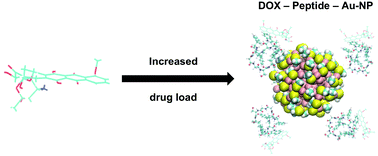A doxorubicin–peptide–gold nanoparticle conjugate as a functionalized drug delivery system: exploring the limits†
Abstract
Efficient transport of pharmaceuticals to malignant cells in the human body often requires the application of drug-delivery systems (DDSs) consisting of several building blocks, each of them bearing a specific function. While nanoparticles are promising as potential carrier moieties, biomolecules may add to the efficient delivery by binding several drug molecules simultaneously. In this contribution, we apply a combination of atomistic molecular dynamics simulations and density functional theory calculations to characterize a multi-component DDS for the transport of the anthracycline antibiotic doxorubicin (DOX), comprising a gold nanoparticle (NP) and a drug-binding peptide (DBP) grafted on the NP surface. We have shown previously that the DDS can stabilize one DOX per DBP. However, by increasing the drug load to a 2 : 1 DOX : DBP ratio the two drug molecules compete for the available adsorption sites, which may cause spontaneous dissociation of one DOX molecule. We identify the chain length of the DBP as a limiting factor for the drug-loading capacity and provide important guidelines for further optimization of multi-component functionalized DDSs.



 Please wait while we load your content...
Please wait while we load your content...